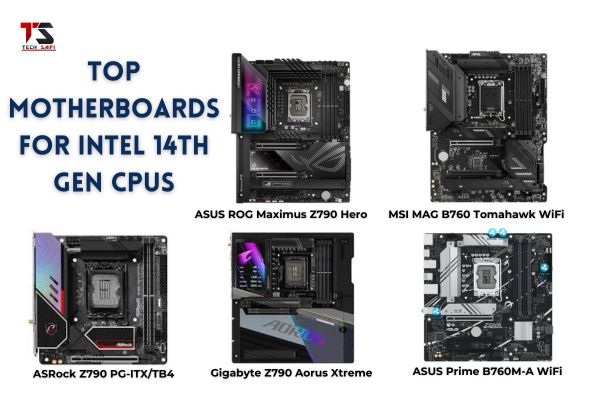The Ultimate Best Motherboards for Intel 14th Gen CPUs
Best Motherboards for Intel 14th Gen CPUs: When building or upgrading a PC, the motherboard is the unsung hero that ties everything together. It’s the foundation that determines what your system can do, how fast it can run, and how future-proof it is. With Intel’s 14th Gen CPUs—codenamed Raptor Lake-S Refresh—now on the market, choosing the right motherboard is more critical than ever. Whether you’re a gamer chasing peak performance, a content creator needing robust connectivity, or a budget-conscious builder, this guide will walk you through the best options and what makes them stand out.
Table of Contents
ToggleIntel’s 14th Gen CPUs and Their Needs
Before diving into motherboards, let’s unpack what makes Intel’s 14th Gen processors unique. These CPUs, like the flagship Core i9-14900K, build on the hybrid architecture of their 13th Gen predecessors, combining Performance (P) and Efficient (E) cores. They support DDR4 and DDR5 memory, PCIe 5.0 lanes for cutting-edge GPUs and storage, and require robust power delivery to handle their turbo boost speeds (up to 6.0 GHz on the i9).
Key considerations for pairing a motherboard:
- Chipset Compatibility: 14th Gen CPUs use the same LGA 1700 socket as 12th/13th Gen, but not all older motherboards support them out of the box.
- Power Delivery: High-core-count CPUs demand motherboards with strong VRMs (Voltage Regulator Modules) to avoid throttling.
- Future-Proofing: PCIe 5.0 slots and DDR5 support are becoming essential for next-gen GPUs and SSDs.
Chipsets Decoded: Z790, B760, and More

Intel’s 700-series chipsets are the go-to for 14th Gen CPUs. Here’s a breakdown:
1. Z790: The Overclocker’s Dream
- Best For: Enthusiasts, gamers, and power users.
- Features: Full overclocking support, up to 20 PCIe 4.0/5.0 lanes, multiple USB 3.2 Gen 2×2 ports, and robust VRMs.
- Why It Matters: Unlocks the full potential of CPUs like the i9-14900K.
2. B760: Budget-Friendly Performance
- Best For: Mid-range builds.
- Features: Limited overclocking, but still supports DDR5 and PCIe 5.0. A sweet spot for cost-conscious builders.
3. H770: The Middle Ground
- Best For: Users wanting more connectivity than B760 without Z790’s price tag.
- Drawback: No CPU overclocking.
Form Factors: Size Matters
Motherboards come in three main sizes:
- ATX: Full-sized boards with ample expansion slots. Ideal for high-end builds.
- Micro-ATX: Compact but sacrifices some PCIe slots. Great for smaller cases.
- Mini-ITX: Tiny footprint for portable builds. Limited to one PCIe slot and two RAM sticks.
Key Features to Look For
1. VRM Quality: Don’t Skimp on Power
The VRM converts power from the PSU to usable voltage for the CPU. A weak VRM can throttle performance. Look for:
- Phases: More phases = smoother power delivery. High-end boards like the ASUS ROG Maximus Z790 Hero use 20+1 phases.
- Heatsinks: Critical for dissipating heat. Boards like the MSI MPG Z790 Edge include extended heatsinks and heat pipes.
2. Connectivity: Ports and Slots
- PCIe 5.0: Future-proof for GPUs and NVMe drives. The Gigabyte Z790 Aorus Master offers PCIe 5.0 x16 and dual PCIe 5.0 M.2 slots.
- USB4/Thunderbolt 4: Essential for creatives. The ASRock Z790 Taichi includes Thunderbolt 4 headers.
- Wi-Fi 6E/7: For wireless enthusiasts.
3. Memory Support: DDR4 vs. DDR5
DDR5 offers higher speeds (up to 7200 MT/s) but costs more. Some boards, like the MSI Pro Z790-A WiFi, support both.
4. Cooling Solutions
Look for M.2 heatsinks, fan headers, and water-pump support. The ASUS TUF Gaming Z790-Plus excels here with multiple cooling zones.
Top Motherboards for Intel 14th Gen CPUs

1. Best Overall: ASUS ROG Maximus Z790 Hero
- Why Buy: 20+1 power stages, PCIe 5.0 x16 slot, five M.2 slots, and Thunderbolt 4. Perfect for overclockers and creators.
- Expert Take: “A no-compromise board with exceptional thermal performance.” — Tom’s Hardware
2. Best Value: MSI MAG B760 Tomahawk WiFi
- Why Buy: Affordable DDR5 support, 12+1+1 VRM design, and Wi-Fi 6E. Ideal for mid-range builds.
- User Review: “Handles my i7-14700K flawlessly.” — Newegg Reviewer
3. Best for Small Form Factor: ASRock Z790 PG-ITX/TB4
- Why Buy: Mini-ITX with Thunderbolt 4, dual PCIe 5.0 M.2 slots, and a 10-layer PCB for stability.
4. Best for Overclocking: Gigabyte Z790 Aorus Xtreme
- Why Buy: 24+1+2 phase VRM, liquid cooling support, and dual PCIe 5.0 slots. Built for pushing limits.
5. Budget Pick: ASUS Prime B760M-A WiFi
- Why Buy: Reliable DDR4 support, 8+1 power stages, and Wi-Fi 6. Great for entry-level builds.
Case Study: Building a 14th Gen Gaming Rig
Scenario: A user pairs the i5-14600K with the MSI MPG Z790 Edge.
- Result: Stable 5.3 GHz overclock, 65°C under load, and seamless DDR5-6400 performance.
- Lesson: Even mid-range CPUs benefit from a quality motherboard.
Future-Proofing Your Build
- PCIe 5.0: Adopted by upcoming GPUs like NVIDIA’s RTX 50-series.
- DDR5: Prices are dropping, making it a wise long-term investment.
Matching Needs to Motherboards
Choosing the right motherboard boils down to your goals:
- Gamers: Prioritize PCIe 5.0 and VRM quality (e.g., ASUS ROG Maximus Z790 Hero).
- Creators: Opt for Thunderbolt 4 and multiple M.2 slots (e.g., Gigabyte Z790 Aorus Master).
- Budget Builders: Balance cost and features (e.g., MSI B760 Tomahawk).
Intel’s 14th Gen CPUs are a powerhouse, but they’re only as good as the motherboard you pair them with. By focusing on chipsets, form factors, and key features like VRMs and connectivity, you’ll build a system that’s ready for today—and tomorrow.

